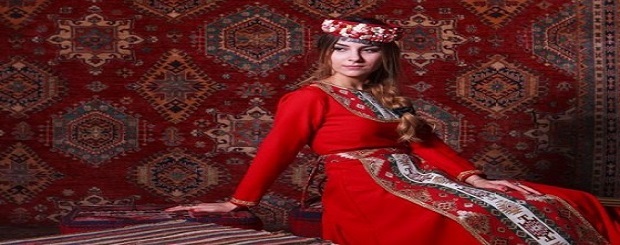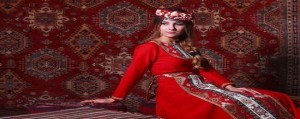
 05 MARCH 2016
05 MARCH 2016
INTERRELATIONSHIP BETWEEN ORNAMENTATION PRINCIPLES OF THE ARTISTIC WEAVING OF THE ARMENIAN CARPET
ICONOGRAPHY IN ARMENIAN WOVEN ART
One of the most ancient types of decorative arts of Armenia is carpeting, an ideal mix of aesthetics, functionality and material culture. A hand woven rug can represent a throne, “holy area,” sign of wealth or royalty, testament or dedicatory object.
Rug weaving is a true folk art. Striking as the carpets are, their geometric patterns were not created solely for aesthetic purposes, but to summon up a symbolic language. A deep red field isn’t just beautiful, it has significance. Four zoomorphic figures arranged around a cross and centered in the field axis doesn’t just form the medallion of the rug, it’s a statement of a specific faith.
The Armenian Wheel of Eternity is one of the countries most ancient and sacred symbols, its origin are traced to the early observations of the sky and worship of the Armenian Deity of the Sun. As one of the most common and sacred symbols of Armenian culture, the Wheel of Eternity stemmed from worship of the sky and the sun, and shares a common origin with the swastika, known as the sun wheel or cross symbol, it represents the sun and time, recurrence, universe and the eternal motion of life.
There exist many variation of the symbol in Armenian culture with overall the same celestial associations but with slightly different metaphors.
Worship of the solar deity continued well into the pre-Christian iconography of the region. During the Iron Age Kingdom of Ararat (860 BC), Armenians frequently used various solar disks and the sacred tree of life in their depictions of deities and sacred rituals.
The solar symbolism was so essential to the Armenians that it made its way into the medieval Armenian culture. Absorbed by the Armenian Christian tradition it became as sacred as the Holy Spirit. The symbol could be seen everywhere in medieval Armenia. From monumental arts, outside and inside church decorations and murals, tomb stones, holy scriptures, Armenian Illuminated Manuscripts, sacred relics that are known as ‘Khachkars’ or ‘Armenian cross-stones’, ceramics, metallurgy, pottery, embroidery, lace and of course on carpets.
In historic Armenia (Greater, Smaller, Higher, Cilicia), carpets were objects of necessity, people ornately covered the walls, ground floors of palaces, public and ecclesiastical buildings with mats, matting and rugs. In most of the settlements, people made flat woven Kilims, house-flannels, coverlets, curtains, saddles and saddlebags, blankets, salt-bags, horse-coverlets and carpets.
This handicraft was so strongly linked with domestic life, learning it became a necessity. Rugs formed an indispensable part in the dowry of Armenian girls who familiarized themselves at an early age with the art and prepared their own dowry of carpets.
Every region in Armenia wove with its own preference of mythological, flora, fauna and other motifs of nature, instruments of labor and domestic articles. As different as they may seem, weavers shared the most patterns of secular and religious icons. Their representations were closely connected with Pagan and Zoroastrian faith, worship rites and superstitions.
Symbols woven in Armenian rugs vary according to their placement in the pattern, changes of color, or slight modifications of shape, much like context, intonation and stress alter the meaning of words in a narrative spoken in a local dialect. But, at its core, rug design is the language of images.
To understand the meaning of designs in Armenian rugs, perhaps one needs to be in a community of spirit attainable only by members of the clan, but ingrained cultural affinity and the deep empathy by an expert is sufficient to grasp the design’s overall meaning.
http://westernarmeniatv.com
